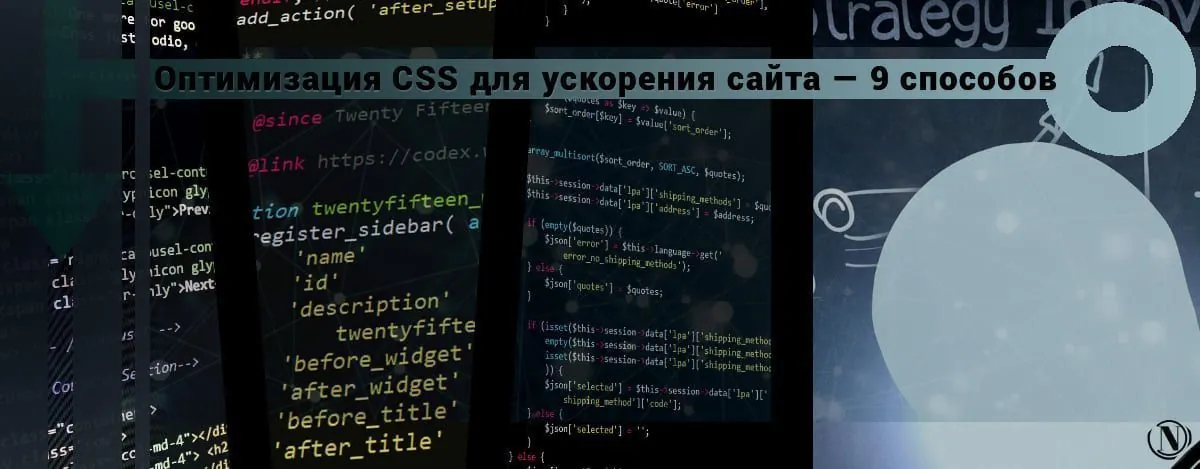Optimizing CSS for Site Speed - 9 Ways

A slow site is always bad! I think the phrase optimization of CSS code to speed up the site, is often present in searches as well as 301 redirects or robots.txt. Or maybe you're the kind of developer who submits websites without caring about optimal performance?
If you belong to the first option, then this article is for you. Now I will tell you about 9 best ways to help you optimize your CSS. These tips will speed up your site and climb in the SERPs. This effect will significantly increase the flow of new visitors to your site.
The content of the article:
- The Importance of Website Speed
- Use Image Sprites
- CSS optimization
- Reduce unnecessary code
- Put CSS tables in the head and JS scripts in the footer
- Separating CSS Files
- Reduce the number of spaces in your code
- Document your code
- Organize your code
- KISS technique (Keep it Simple Stupid)
The Importance of Site Speed for Organic Ranking

You will be surprised about the importance of faster websites. There are several main reasons, but their influence significantly affects the position of the site. Main reasons:
- Web site visitors don't like to wait a long time for a page to fully load;
- Your customers will definitely return to the site if it works fast; Faster sites always rank higher in search engines;
- Also site speed adds value to your SEO strategy;
These resources are just awesome and make a great impression. Now what would you do to make your site faster? Of course, improving this situation may require many actions from you.
For example upgrading your server, RAM, storage or hardware in general. But did you know that the main reason for a slow site lies in your source code? Lack of optimized CSS is the most common reason. This means that reducing the file size of your style sheet by even a few kilobytes will have a significant impact on your page load time.
Use Image Sprites
CSS Sprites is a means of combining multiple images into a single image file. Further use it on the website to improve performance. This use of image sprites is an old technique. When it comes to reducing the CSS file size and reducing page load times, this technique is a must.
Image sprites allow you to pack images into one large .png file. This method reduces HTTP requests and speeds up page load times. An image sprite is a great choice if you use a lot of icons and graphics on your site. This option will significantly reduce the overhead of having to extract multiple images.
CSS optimization
Shortening CSS is simply compressing your file into a new file with as few spaces as possible. The smaller the code, the faster it will be read by the user's browser.
Of course, you don't have to do it manually as there are automatic compressors on the internet. Only thanks to such simple online tools, it is possible to carry out compression in a matter of minutes. Here is one such minifier: http://www.cssminifier.com
Reduce unnecessary code
We don't need repeated code. Code like this greatly slows down the loading of elements. The browser needs to go through duplicate code repeatedly, spending an extra fraction of a second on this. Another trick to increase page loading speed is to reduce unnecessary code. Such an improvement can be achieved by checking for redundant or duplicate code.
Put CSS tables in the head and JS scripts in the footer
It's good practice to put the style sheet at the top (between the head tags) and the JavaScript code at the bottom. Make sure your code loads before the rest of the page. The main reason for placing JavaScript at the bottom of the site is its large size. As well as its further impact on website speed. Therefore, such scripts are placed at the bottom of the site. This allows them to load after the main components of the page.
The essential styles needed to style the content at the top of the page are inlined and immediately applied to the document. The complete small.css file is loaded after the initial rendering of the page. Its styles are applied to the page after it has finished loading, without blocking the initial rendering of critical content.
Don't embed big data URIs
Be careful when embedding data URIs in style files. While selectively using small data URIs in your CSS can make sense, embedding big data URIs can cause your CSS to be larger at the top of the fold, slowing down page rendering time.
Don't embed CSS attributes
Embedding CSS attributes in HTML elements (such as ) should be avoided whenever possible, as this often leads to unnecessary duplication of code. Also, inline CSS in HTML elements is blocked by Content Security Policy (CSP) by default.
Separating CSS Files
Also you can separate CSS files i.e. different stylesheets. For example, if you are targeting multiple browsers such as IE, Chrome or Firefox. For example, instead of checking for CSS hacks in one style sheet, you can use IE conditional statements to load another style sheet (for IE6, for example). This way you won't load IE code when using Chrome. This will greatly reduce the size of the CSS file.
Reduce the number of spaces in your code
You should always try to reduce the amount of whitespace in your CSS. Increasing white space takes up free bytes. This can make a difference between a faster and slower site in very large projects. By reducing the amount of white space, the weight of CSS is reduced. Thus, we speed up the download of the file, due to the lower weight.
Document your code
You should document your code wherever possible. Using CSS comments like /* Comment here */ can help you identify useless code. Although adding comments takes up a lot of space, it is easy to neglect them. In some cases, useless comments are simply deleted. This technique allows you to get rid of excess weight of CSS in a very productive way.
Organize your code
CSS Code Optimization is a technique that many would not even think about talking about. In fact, on many levels, organizing your code can help you significantly reduce file size. As a result, increase the speed of your site. I wonder how? It's very simple.
Put your CSS classes in the correct set of branches. This method guarantees minimal duplication. Unorganized code is a common problem in modern web design. In some scenarios, organizing your messy code into hierarchical branches is all you need to get your site to load. Try to avoid CSS hacks in a single style sheet. Instead, use the methods indicated in points 5 and 8.
KISS technique (Keep it Simple Stupid)
The last word is to make sure everything you do is in keeping with the KISS technique. KISS stands for Keep it Simple Stupid. If you create a file again! Then you should definitely be on the right path to organized, well-written, less redundant and clean code. As you can see, optimizing CSS is not difficult. Especially in some cases, you can get by with a couple of paragraphs of this article. These techniques will help speed up the site at times.
Reading this article:
- Optimizing JS and CSS site code online - a detailed guide
- Website technical optimization - the most important actions
Thanks for reading: SEO HELPER | NICOLA.TOP









